Proposed Model of Sustainable Construction Skills for Engineers in Chile
Abstract
1. Introduction
2. Methods
3. Results
4. Discussions
5. Conclusions
Author Contributions
Funding
Acknowledgments
Conflicts of Interest
References
- Yepes, V.; Pellicer, E.; Ortega, A.J. Designing a benchmark indicator for managerial competences in construction at the graduate level. J. Prof. Issues Eng. Educ. Pract. 2011, 138, 48–54. [Google Scholar] [CrossRef]
- Chau, K.W. Incorporation of sustainability concepts into a civil engineering curriculum. J. Prof. Issues Eng. Educ. Pract. 2007, 133, 188–191. [Google Scholar] [CrossRef]
- Caetano, N.; López, D.; Cabré, J. Learning sustainability and social compromise skills—A new track is born. In Proceedings of the 3rd International Conference on Technological Ecosystems for Enhancing Multiculturality, Porto, Portugal, 7–9 October 2015; pp. 525–528. [Google Scholar]
- Striebig, B.A. Building life cycle assessment skills with GREET and SimaPro to engage students in analyzing the sustainability of biofuel alternatives. In Proceedings of the 2017 ASEE Annual Conference and Exposition, Columbus, OH, USA, 25–28 June 2017. [Google Scholar]
- Kexin, Y.; Wanlong, L.; Ke, Y. Research on the skill teaching reform of higher vocational education from the perspective of sustainability: Case study of software college. In Proceedings of the ICCSE 2016—11th International Conference on Computer Science and Education, Nagoya, Japan, 23–25 August 2016; pp. 894–898. [Google Scholar]
- Heiskanen, E.; Thidell, Å.; Rodhe, H. Educating sustainability change agents: The importance of practical skills and experience. J. Clean. Prod. 2016, 123, 218–226. [Google Scholar] [CrossRef]
- Tarrant, S.P.; Thiele, L.P. Practice makes pedagogy—John Dewey and skills-based sustainability education. Int. J. Sustain. High. Educ. 2016, 17, 54–67. [Google Scholar] [CrossRef]
- McBain, B.; Phelan, L. Building students’ communication skills and understanding of environmental and sustainability issues interactively and cumulatively with Pecha Kucha presentations. In Learner-Centered Teaching Activities for Environmental and Sustainability Studies; Springer: Berlin, Germany, 2016; pp. 279–284. [Google Scholar]
- Ospino-Castro, A.; Silva-Ortega, J.I.; Muñoz-Maldonado, Y.; Candelo Becerra, J.E.; Mejia-Taboada, M.; Valencia-Ochoa, G.; Umaña-Ibañez, S. Innovation strategies to develop specific professional skills on photovoltaic systems using laboratory experience guides: Technologies and sustainability education. Espacios 2016, 37, 10–21. [Google Scholar]
- Truscheit, A.; Otte, C. Sustainable games people play: Teaching sustainability skills with the aid of the rol-play ‘NordWestPower’. Green. Manag. Int. 2004, 48, 51–56. [Google Scholar] [CrossRef]
- De la Riva, G.A.; Espinosa Fajardo, C.C.; Juárez Nájera, M. Sustainability in engineering education: An approach to reach significant learning and character skills. In Sustainability in Higher Education; Elsevier Ltd.: New York City, NY, USA, 2015; pp. 97–125. [Google Scholar]
- Helen Brain, R.G.; Thomas, B.H. Undergraduate students as sustainability consultants: Applying service-learning to enhance career skills and foster community environmental sustainability. Sustainability 2013, 6, 277–281. [Google Scholar] [CrossRef]
- Forment, M.A.; López, D.; Carracedo, F.S.; Almiñana, J.G.; Poch, J.P.; Velasco, M. Using a Crowdsourcing Knowledge Base to Support the Sustainability and Social Compromise Skill in Computer Science Engineering Studies. Commun. Comput. Inf. Sci. 2013, 278, 51–260. [Google Scholar]
- Kibert, C.J. Sustainable Construction. In Proceedings of the First International Conference of CIB TG 16, Tampa, FL, USA, 6–9 November 1994. [Google Scholar]
- Shen, L.; Tam, V.W.Y.; Tam, L.; Ji, Y. Project feasibility study: The key to successful implementation of sustainable and socially responsible construction management practice. J. Clean. Prod. 2010, 18, 254–259. [Google Scholar] [CrossRef]
- Tzikopoulos, A.F.; Karatza, M.C.; Paravantis, J.A. Modelling energy efficiency of bioclimatic buildings. Energy Build. 2005, 37, 529–544. [Google Scholar] [CrossRef]
- Eires, R.; Nunes, J.P.; Fangueiro, R.; Jalali, S.; Camões, A. New eco-friendly hybrid composite materials for civil construction. In Proceedings of the 12th European Conference on Composites Materials, Biarritz, France, 29 August–1 September 2016. [Google Scholar]
- Kibriya, T. Sustainable Construction—Use of masonry demolition waste in concrete. Gulustan–Black Sea Sci. J. Acad. Res. 2017, 38, 25–36. [Google Scholar]
- Inim, I.J.; Affiah, U.E.; Eminue, O.O. Assessment of bamboo leaf ash/lime-stabilized lateritic soils as construction materials. Innov. Infrastruct. Solut. 2018, 3, 32. [Google Scholar] [CrossRef]
- Herrera, M.; Soto, D. Renewable Insulation materials constructed from Colombian materials according to the principles of Sustainable Development: A review of possibilities. TECCIENCIA 2018, 13, 27–42. [Google Scholar]
- Srivastava, S.K.; Asthana, A. Study of Ecofriendly Light Weight Bricks using waste Paper—A Review. Carbon 2017, 5, 2. [Google Scholar]
- Vishwakarma, V.; Ramachandran, D. Green Concrete mix using solid waste and nanoparticles as alternatives—A review. Constr. Build. Mater. 2018, 162, 96–103. [Google Scholar] [CrossRef]
- Pérez-Fargallo, A.; Rubio-Bellido, C.; Pulido-Arcas, J.A.; Gallego-Maya, I.; Guevara-García, F.J. Influence of Adaptive Comfort Models on Energy Improvement for Housing in Cold Areas. Sustainability 2018, 10, 859. [Google Scholar] [CrossRef]
- Nicol, J.F.; Humphreys, M.A. Adaptive thermal comfort and sustainable thermal standards for buildings. Energy Build. 2002, 34, 563–572. [Google Scholar] [CrossRef]
- Rupp, R.F.; Vásquez, N.G.; Lamberts, R. A review of human thermal comfort in the built environment. Energy Build. 2015, 105, 178–205. [Google Scholar] [CrossRef]
- Taleghani, M.; Tenpierik, M.; Kurvers, S.; Van Den Dobbelsteen, A. A review into thermal comfort in buildings. Renew. Sustain. Energy Rev. 2013, 26, 201–215. [Google Scholar] [CrossRef]
- Halawa, E.; Van Hoof, J. The adaptive approach to thermal comfort: A critical overview. Energy Build. 2012, 51, 101–110. [Google Scholar] [CrossRef]
- Zomorodian, Z.S.; Tahsildoost, M.; Hafezi, M. Thermal comfort in educational buildings: A review article. Renew. Sustain. Energy Rev. 2016, 59, 895–906. [Google Scholar] [CrossRef]
- Singh, R.; Lazarus, I.J. Energy-Efficient Building Construction and Embodied Energy. In Sustainability through Energy-Efficient Buildings; CRC Press: Boca Raton, FL, USA, 2018. [Google Scholar]
- Shukla, A.; Sharma, A. Sustainability through Energy-Efficient Buildings; CRC Press: Boca Raton, FL, USA, 2018. [Google Scholar]
- D’Agostino, D. Improving Energy Efficiency in Buildings: Challenges and Opportunities in the European Context. In Sustainability through Energy-Efficient Buildings; CRC Press: Boca Raton, FL, USA, 2018. [Google Scholar]
- Mishra, S. Energy-Efficient Buildings: Technology to Policy and Awareness. In Sustainability through Energy-Efficient Buildings; CRC Press: Boca Raton, FL, USA, 2018. [Google Scholar]
- Chaturvedi, A.K.; Jain, S.; Gupta, D.; Singh, M. Advances in Energy-Efficient Buildings for New and Old Buildings. In Sustainability through Energy-Efficient Buildings; CRC Press: Boca Raton, FL, USA, 2018. [Google Scholar]
- Wang, Z.; Zhao, J. Optimization of Passive Envelop Energy Efficient Measures for Office Buildings in Different Climate Regions of China Based on Modified Sensitivity Analysis. Sustainability 2018, 10, 907. [Google Scholar] [CrossRef]
- Acosta, D.; Cilento Sarli, A. Edificaciones Sostenibles: Estrategias de investigación y desarrollo. Tecnol. Constr. 2005, 21, 15–30. [Google Scholar]
- Sartori, I.; Hestnes, A.G. Energy use in the life cycle of conventional and low-energy buildings: A review article. Energy Build. 2007, 39, 249–257. [Google Scholar] [CrossRef]
- Ramesh, T.; Prakash, R.; Shukla, K.K. Life cycle energy analysis of buildings: An overview. Energy Build. 2010, 42, 1592–1600. [Google Scholar] [CrossRef]
- Bustamante, W.; Bobadilla, A.; Navarrete, B.; Saelzer, G.; Vidal, S. Uso eficiente de la energía en edificios habitacionales. Mejoramiento térmico de muros de albañilería de ladrillos cerámicos. El caso de Chile. Rev. Constr. 2005, 4, 5–12. [Google Scholar]
- Milne, M.J.; Gray, R. Wither ecology? The triple bottom line, the global reporting initiative, and corporate sustainability reporting. J. Bus. Ethics 2013, 118, 13–29. [Google Scholar] [CrossRef]
- Lozano, R.; Ceulemans, K.; Alonso-Almeida, M.; Huisingh, D.; Lozano, F.J.; Waas, T.; Huge, J. A review of commitment and implementation of sustainable development in higher education: Results from a worldwide survey. J. Clean. Prod. 2005, 108, 1–18. [Google Scholar] [CrossRef]
- Lozano, R.; Lukman, R.; Lozano, F.J.; Huisingh, D.; Lambrechts, W. Declarations for sustainability in higher education: Becoming better leaders, through addressing the university system. J. Clean. Prod. 2013, 48, 10–19. [Google Scholar] [CrossRef]
- Ministerio de Obras Públicas (MOP); Ministerio de Vivienda y Urbanismo (MINVU); Ministerio de Energía (Minenergía); Ministerio de Medio Ambiente (MMA). Estrategia Nacional de Construcción Sustentable; Res. Ex. N 9035; MOP, MINVU, Minenergía, MMA: Santiago, Chile, 2013. [Google Scholar]
- Kevern, J.T. Green building and sustainable infrastructure: Sustainability education for civil engineers. J. Prof. Issues Eng. Educ. Pract. 2010, 137, 107–112. [Google Scholar] [CrossRef]
- Clevenger, C.M.; Ozbek, M.E. Service-learning assessment: Sustainability competencies in construction education. J. Constr. Eng. Manag. 2013, 139, A4013010. [Google Scholar] [CrossRef]
- Wiek, A.; Withycombe, L.; Redman, C.L. Key competencies in sustainability: A reference framework for academic program development. Sustain. Sci. 2011, 6, 203–218. [Google Scholar] [CrossRef]
- Frisk, E.; Larson, K.L. Educating for sustainability: Competencies & practices for transformative action. J. Sustain. Educ. 2011, 2, 1–20. [Google Scholar]
- Cebrián, G.; Junyent, M. Competencies in Education for Sustainable Development: Exploring the Student Teachers’ Views. Sustainability 2015, 7, 2768–2786. [Google Scholar] [CrossRef]
- Lozano, R.; Merrill, M.Y.; Sammalisto, K.; Ceulemans, K.; Lozano, F.J. Connecting Competences and Pedagogical Approaches for Sustainable Development in Higher Education: A Literature Review and Framework Proposal. Sustainability 2017, 9, 1889. [Google Scholar] [CrossRef]
- Aznar Minguet, P.; Ull Solís, M. La formación de competencias Básicas para el desarrollo sostenible: El papel de la universidad. Rev. Educ. 2009, 1, 219–237. [Google Scholar]
- McClelland, D.C. Testing for Competencies rather than intelligence. Am. Psychol. 1973, 28, 1–14. [Google Scholar] [CrossRef] [PubMed]
- Chomsky, N. Aspectos de la Teoría Sintaxis; Editorial Aguilar: Madrid, Spain, 1970. [Google Scholar]
- Bunk, G.P. La transmisión de las competencias en la formación y perfeccionamiento profesionales de la RFA. Rev. Eur. Form. Prof. 1994, 1, 8–14. [Google Scholar]
- Aznar Minguet, P. El reto Educativo de la Sostenibilidad en el marco del Espacio Europeo de la Educación Superior; Biblioteca Nueva: Madrid, Spain, 2006. [Google Scholar]
- García-Montalvo, J.; Mora, J.G. El mercado laboral de los titulados superiores en Europa y en España. Pap. Econ. Esp. 2000, 86, 111–127. [Google Scholar]
- Puyol, J. Análisis Ocupacional: Manual de Aplicación para Instituciones de Formación; Cinterfor: Montevideo, Uruguay, 1980. [Google Scholar]
- Bondehagen, D.L.; Komisar, S.J. Continuing assessment of sustainability skills in the environmental and civil engineering curriculum. In Proceedings of the 2017 ASEE Annual Conference and Exposition, Columbus, OH, USA, 25–28 June 2017. [Google Scholar]
- Maulida, N.I.; Firman, H.; Rusyati, L. Profile of Students’ Critical Thinking Skill Measured by Science Virtual Test on Living Things and Environmental Sustainability Theme. J. Phys. Conf. Ser. 2017, 812, 012058. [Google Scholar] [CrossRef]
- Sivapalan, S. Sustainability, blended learning and the undergraduate communication skills classroom: Negotiating engineering undergraduates’ expectations and perceptions. On Horiz. 2017, 25, 7–23. [Google Scholar] [CrossRef]
- Bondehagen, D.L.; Komisar, S.J.; O’Neill, R. Assessing achievement of sustainability skills in the environmental and civil engineering curriculum. In Proceedings of the 2017 ASEE Annual Conference and Exposition, Columbus, OH, USA, 25–28 June 2017. [Google Scholar]
- Hess, J.L.; Brownell, S.A.; House, R.A. Development and application of the sustainability skills and dispositions scale to the wicked problems in sustainability initiative. In Proceedings of the 2015 ASEE Annual Conference and Exposition, Seattle, WA, USA, 14–17 June 2015. [Google Scholar]
- Chandu, R.S.; Kancharla, N.A. Skill acquisition in engineering education for achieving sustainability. In Proceedings of the AICERA 2012—Annual International Conference on Emerging Research Areas: Innovative Practices and Future Trends, Kottayam, India, 19–21 July 2012. [Google Scholar]
- Gough, D.; Oliver, S.; Thomas, J. An Introduction to Systematic Reviews; Sage: Thousand Oaks, CA, USA, 2017. [Google Scholar]
- Popay, J.; Roberts, H.; Sowden, A.; Petticrew, M.; Arai, L.; Rodgers, M.; Duffy, S. Guidance on the Conduct of Narrative Synthesis in Systematic Reviews: A Product from the Esrc Methods Programme; Institute for Health Research: London, UK, 2006. [Google Scholar]
- Tranfield, D.; Denyer, D.; Smart, P. Towards a methodology for developing evidence-informed management knowledge by means of systematic review. Br. J. Manag. 2003, 14, 207–222. [Google Scholar] [CrossRef]
- Irigoin, M.; Vargas, F. Competencia Laboral: Manual de Conceptos, Métodos y Aplicaciones en el Sector Salud; Cinterfor: Montevideo, Uruguay, 2002; p. 252. [Google Scholar]
- Norton, R. DACUM Handbook, 2nd ed.; The Ohio State University: Columbus, OH, USA, 1997. [Google Scholar]
- Tobon, S. Formación Basada en Competencias; ECOE Ediciones: Bogota, Columbia, 2005. [Google Scholar]
- Tobón, S. Aspectos Básicos de la Formación Basada en Competencias; Proyecto Mesesup: Talca, Chile, 2006. [Google Scholar]
- Hernández Sampieri, R.; Fernández Collado, C.; Baptista Lucio, P. Diseños de Investigación; Metodología de la Investigación: Mexico City, Mexico, 2003. [Google Scholar]
- Kibert, C.J. Sustainable Construction: Green Building Design and Delivery; John Wiley & Sons: Hoboken, NJ, USA, 2016. [Google Scholar]
- Labuschagne, C.; Brent, A.C. Sustainable project life cycle management: The need to integrate life cycles in the manufacturing sector. Int. J. Proj. Manag. 2005, 23, 159–168. [Google Scholar] [CrossRef]
- Amini, M.; Bienstock, C.C. Corporate sustainability: An integrative definition and framework to evaluate corporate practice and guide academic research. J. Clean. Prod. 2014, 76, 12–19. [Google Scholar] [CrossRef]
- Bocken, N.M.; Short, S.W.; Rana, P.; Evans, S. A literature and practice review to develop sustainable business model archetypes. J. Clean. Prod. 2014, 65, 42–56. [Google Scholar] [CrossRef]
- Crawford, L. Leading Sustainability through Projects. In Sustainability Integration for Effective Project Management; IGI Global: Hershey, PA, USA, 2013; pp. 235–244. [Google Scholar]
- Akreim, M.A.; Suzer, O. Motivators for Green Buildings: A Review. Environ. Manag. Sustain. Dev. 2018, 7, 137–156. [Google Scholar] [CrossRef]
- Finocchiaro, L.; Lobaccaro, G. Bioclimatic Design of Green Buildings. In Handbook of Energy Systems in Green Buildings; Springer: Berlin, Germany, 2017. [Google Scholar]
- Spangenberg, J.H. Design for sustainability (DfS): Interface of sustainable production and consumption. In Handbook of Sustainable Engineering; Springer: Dordrecht, The Netherlands, 2013; pp. 575–595. [Google Scholar]
- Bovea, M.; Pérez-Belis, V. A taxonomy of ecodesign tools for integrating environmental requirements into the product design process. J. Clean. Prod. 2012, 20, 61–71. [Google Scholar] [CrossRef]
- Martínez, P.; González, V.; Da Fonseca, E. Integración conceptual Green Lean en el diseño, planificación, y construcción de proyectos. Rev. Ing. Constr. 2009, 24, 5–32. [Google Scholar]
- Gulati, R.; Kletter, D. Shrinking core, expanding periphery: The relational architecture of high-performing organizations. Calif. Manag. Rev. 2005, 47, 77–104. [Google Scholar] [CrossRef]
- Borges, M.; Benett, Y.; Lewis, M.; Thorn, M. An Expert System Approach to Curriculum Development in Engineering Education. Eur. J. Eng. Educ. 1994, 19, 175–189. [Google Scholar] [CrossRef]
- Callejón-Ferre, Á.J.; López-Martínez, J.A.; Carreño-Ortega, Á. Adaptación y desarrollo de la asignatura Motores y máquinas de la titulación de Ingeniero Técnico Agrícola en Industrias Agrarias y alimentarias ante el Espacio Europeo de Educación Superior. Rev. Form. Innov. Educ. Univ. 2010, 3, 141–151. [Google Scholar]
- Saldaña-Márquez, H.; Gómez-Soberón, J.M.; Arredondo-Rea, S.P.; Gámez-García, D.C.; Corral-Higuera, R. Sustainable social housing: The comparison of the Mexican funding program for housing solutions and building sustainability rating systems. Build. Environ. 2018, 133, 103–122. [Google Scholar] [CrossRef]
- Saldaña-Márquez, H.; Gómez-Soberón, J.M.; Arredondo-Rea, S.P.; Almaral-Sánchez, J.L.; Gómez-Soberón, M.C.; Rosell-Balada, G. The passivhaus standard in the mediterranean climate: Evaluation, comparison and profitability. J. Green Build. 2015, 10, 55–72. [Google Scholar] [CrossRef]
- Seager, T.P.; Selinger, E. Experiential teaching strategies for ethical reasoning skills relevant to sustainability. In Proceedings of the 2009 IEEE International Symposium on Sustainable Systems and Technology, Phoenix, AZ, USA, 18–20 May 2009. [Google Scholar]
- Royal, C.; O’Donnell, L. Education for sustainability: Creating skills in human capital analysis. J. Inf. Knowl. Manag. 2007, 6, 115–125. [Google Scholar] [CrossRef]
- Gómez-Soberón, J.M.; Gómez-Soberón, M.C.; Saldaña-Márquez, H.; Gámez-García, D.C.; Arredondo-Rea, S.P.; Corral-Higuera, R. Comparative by simulating the eventual waste generation of building indoor pavements construction. In Proceedings of the 2016 World Congress on Sustainable Technologies, London, UK, 12–14 December 2016; pp. 117–121. [Google Scholar]
- Cabrera-Covarrubias, F.G.; Gómez-Soberón, J.M.; Almaral-Sánchez, J.L.; Arredondo-Rea, S.P.; Gómez-Soberón, M.C.; Corral-Higuera, R. An experimental study of mortars with recycled ceramic aggregates: Deduction and prediction of the stress-strain. Materials 2016, 9, 1029. [Google Scholar] [CrossRef] [PubMed]
- Cabrera-Covarrubias, F.G.; Gómez-Soberón, J.M.; Almaral-Sánchez, J.L.; Arredondo-Rea, S.P.; Corral-Higuera, R. Mechanical properties of mortars containing recycled ceramic as a fine aggregate replacement. Rev. Constr. 2015, 14, 22–29. [Google Scholar] [CrossRef]
- Gómez-Soberón, J.M.; Gómez-Soberón, M.C.; Corral-Higuera, R.; Arredondo-Rea, S.P.; Almaral-Sánchez, J.L.; Cabrera-Covarrubias, F.G. Calibrating questionnaires by psychometric analysis to evaluate knowledge. SAGE Open 2013, 3, 1–14. [Google Scholar] [CrossRef]
- Vázquez, Y.A. Educación basada en competencias. In Educar Revista de Educación/Nueva Época; Universidad Iberoamericana Puebla: San Andrés Cholula, Mexico, 2001; pp. 39–61. [Google Scholar]
- Bukosky, M.; Montero, C.; Perez, D.; Bambill, E.; Amado, L. Educación Para el Desarrollo Sustentable en Ingeniería Civil de la FRBB-UTN. In Proceedings of the I Congreso Latinoamericano de Ingeniería, Entre Ríos, Argentina, 13–15 September 2017. [Google Scholar]
- Echenique, B.P. La enseñanza integral de la arquitectura, desde la perspectiva de la sostenibilidad ambiental. Módulo Arquitectura CUC 2016, 16, 35–58. [Google Scholar]
- The ImpEE Project. Improving Engineering Education; University of Cambridge: Cambridge, UK, 2006. (In Spinish) [Google Scholar]
- Garcia, F. El Patrimonio y las Normas de Certificación Sustentable en Arquitectura e Ingeniería Civil. Available online: http://www.icomos.org.ar/wp-content/uploads/2013/05/garciazuiga.pdf (accessed on 30 March 2018).
- Escobar, C.A.R. El componente energético en los programas de estudios de ingeniería ambiental. Rev. Clepsidra 2006, 2, 115–123. [Google Scholar]
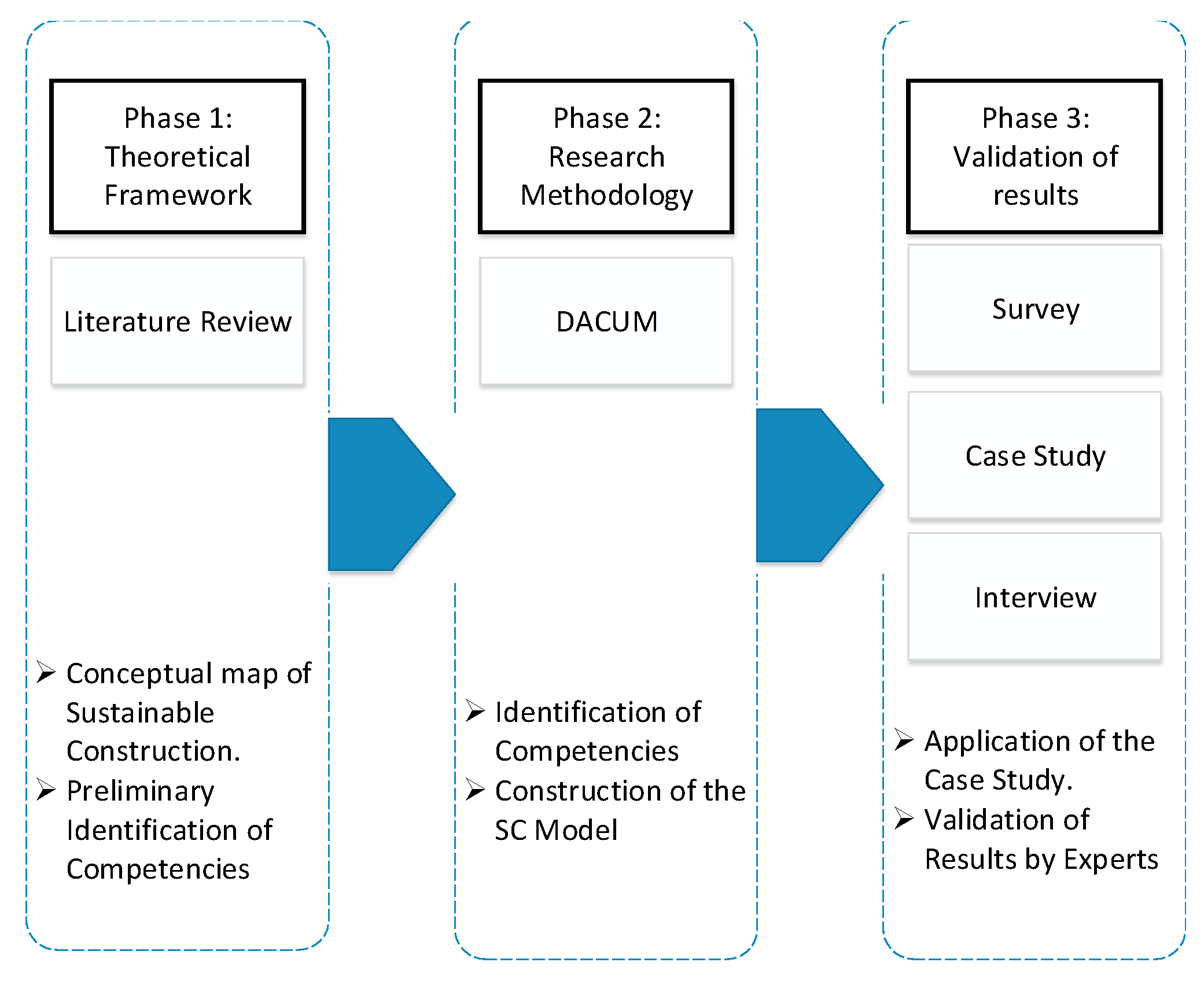
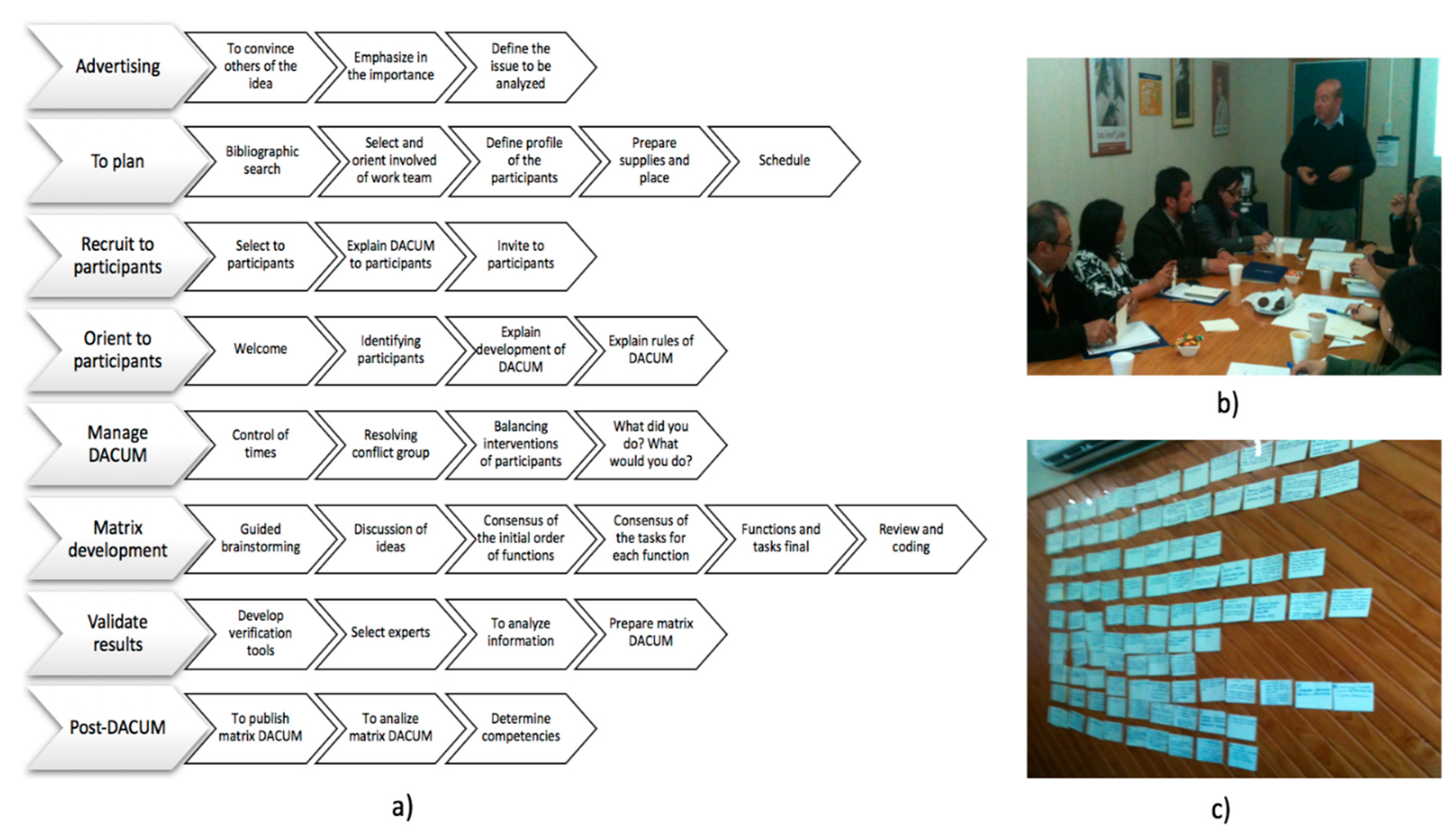
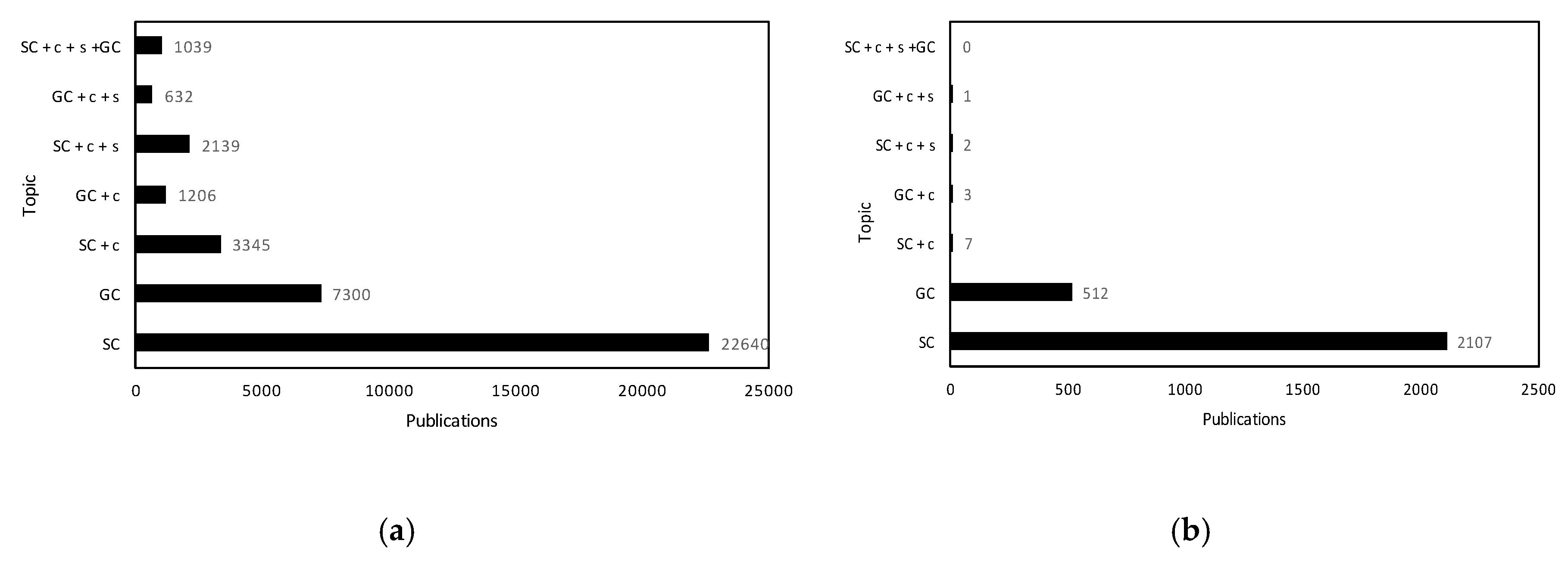
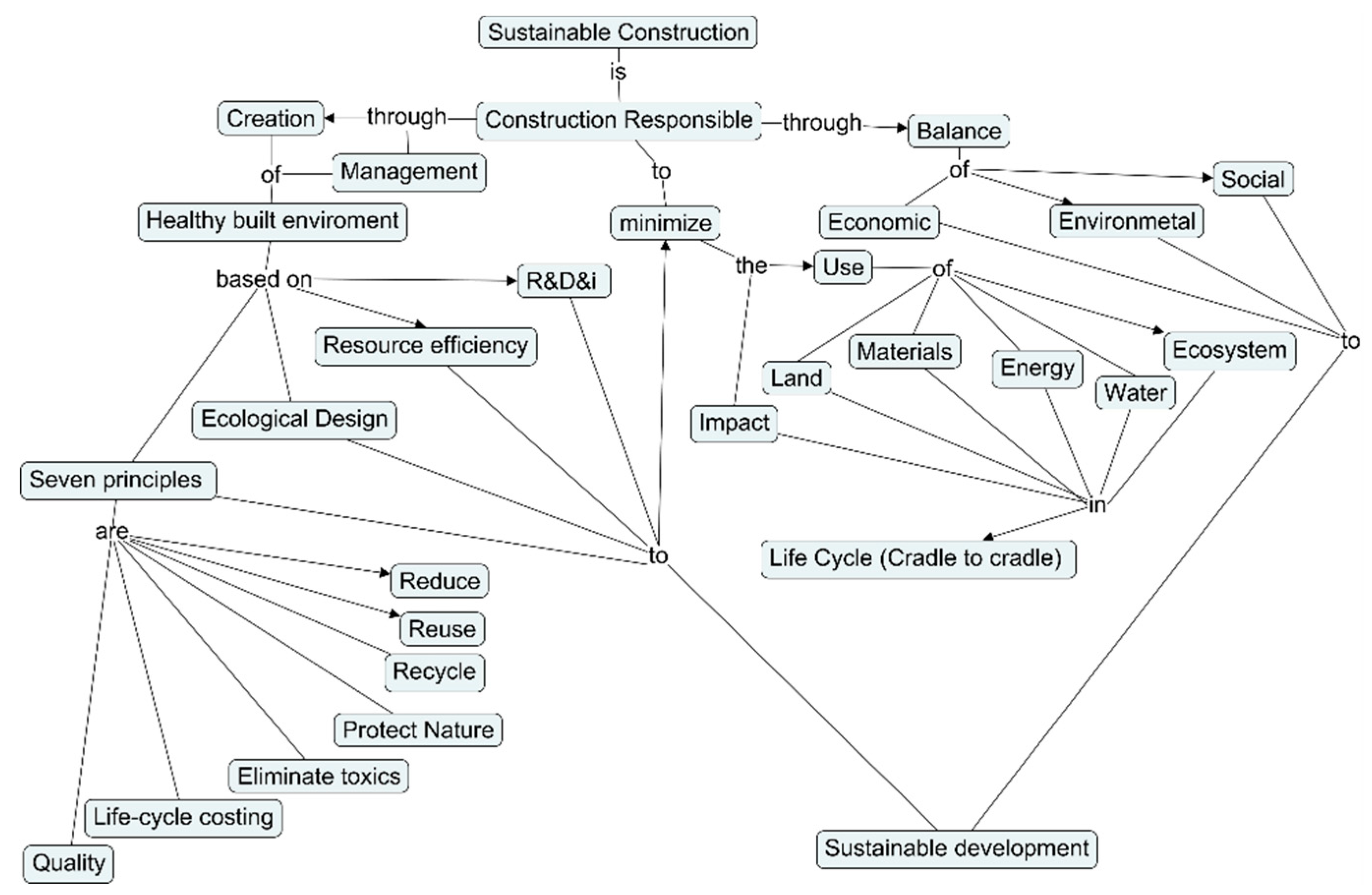
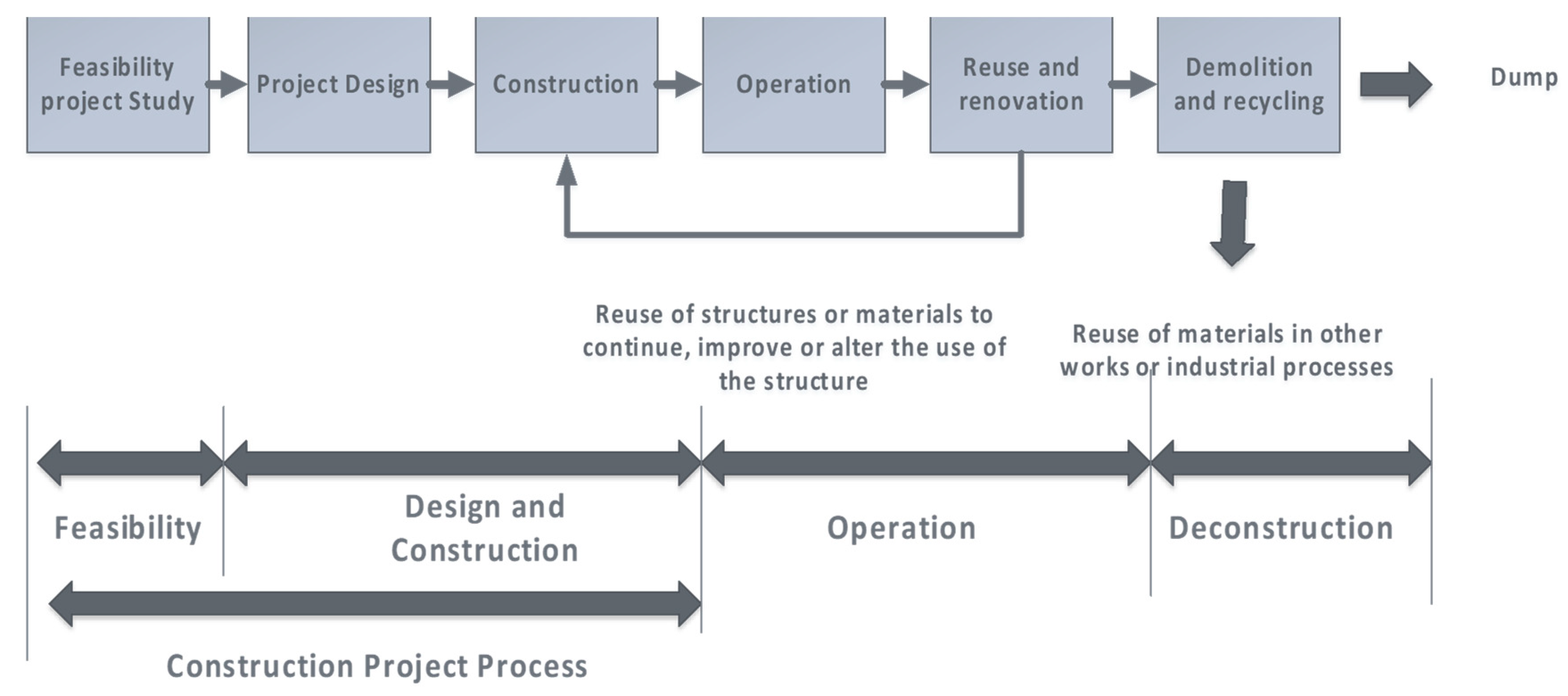
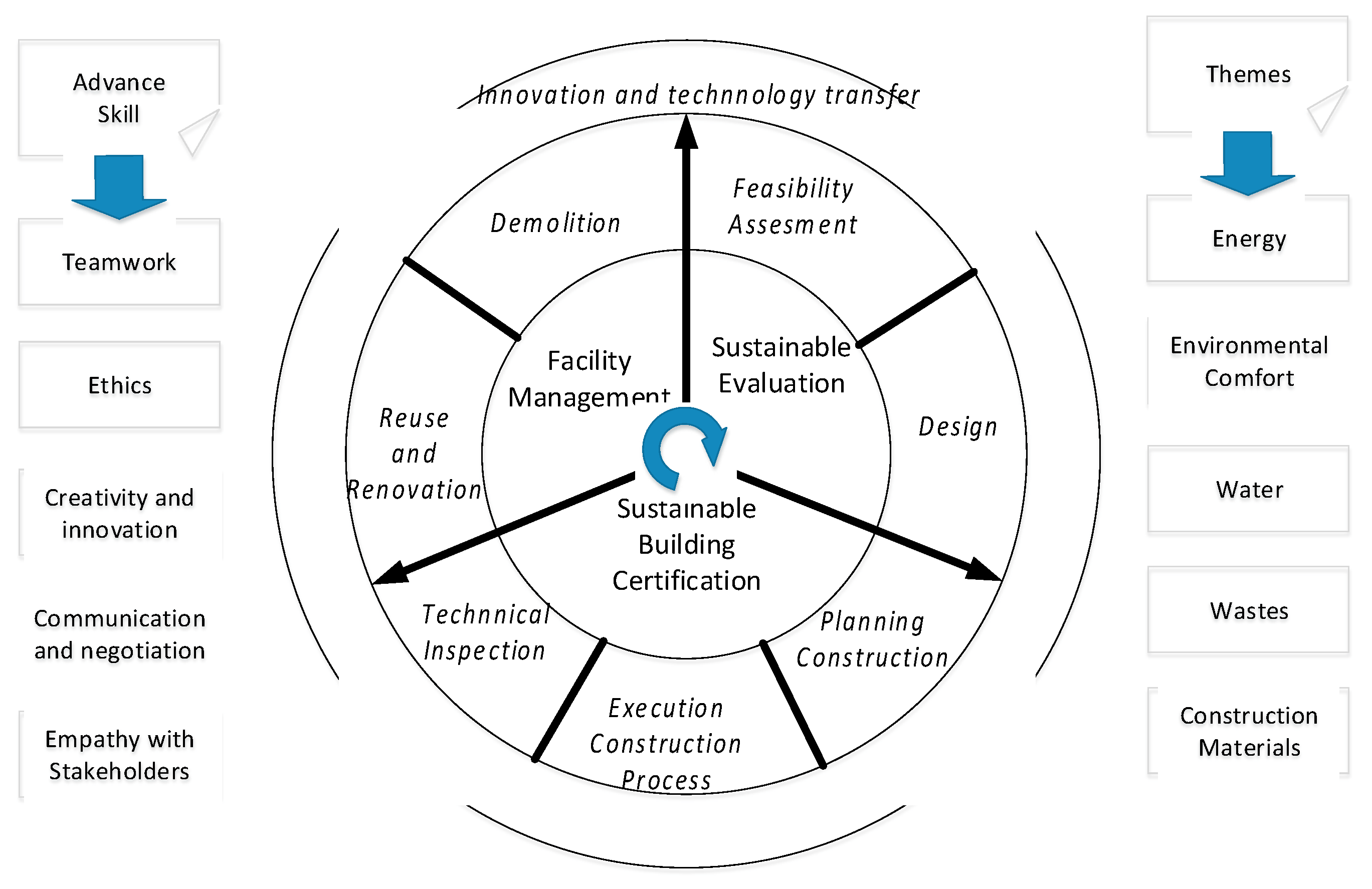
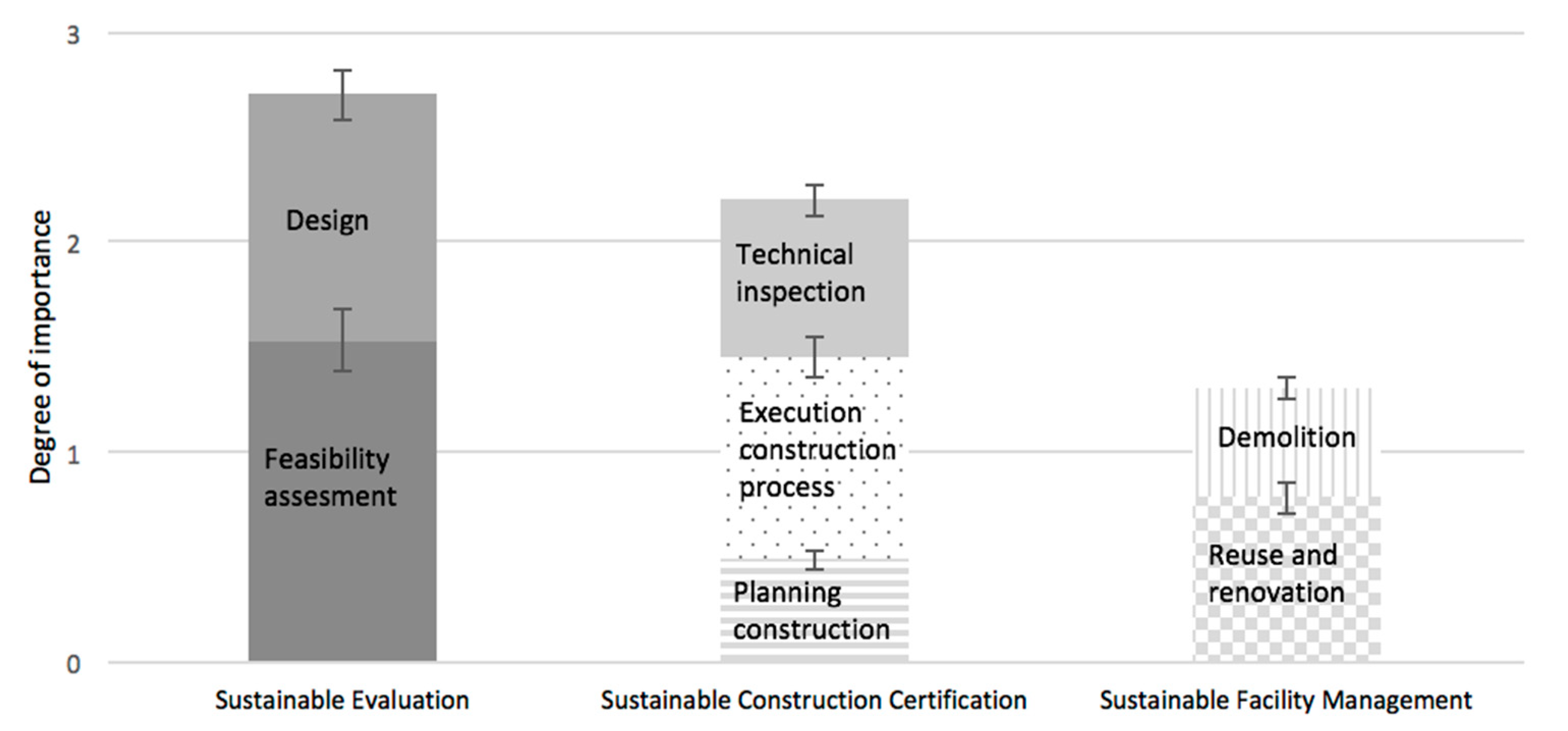
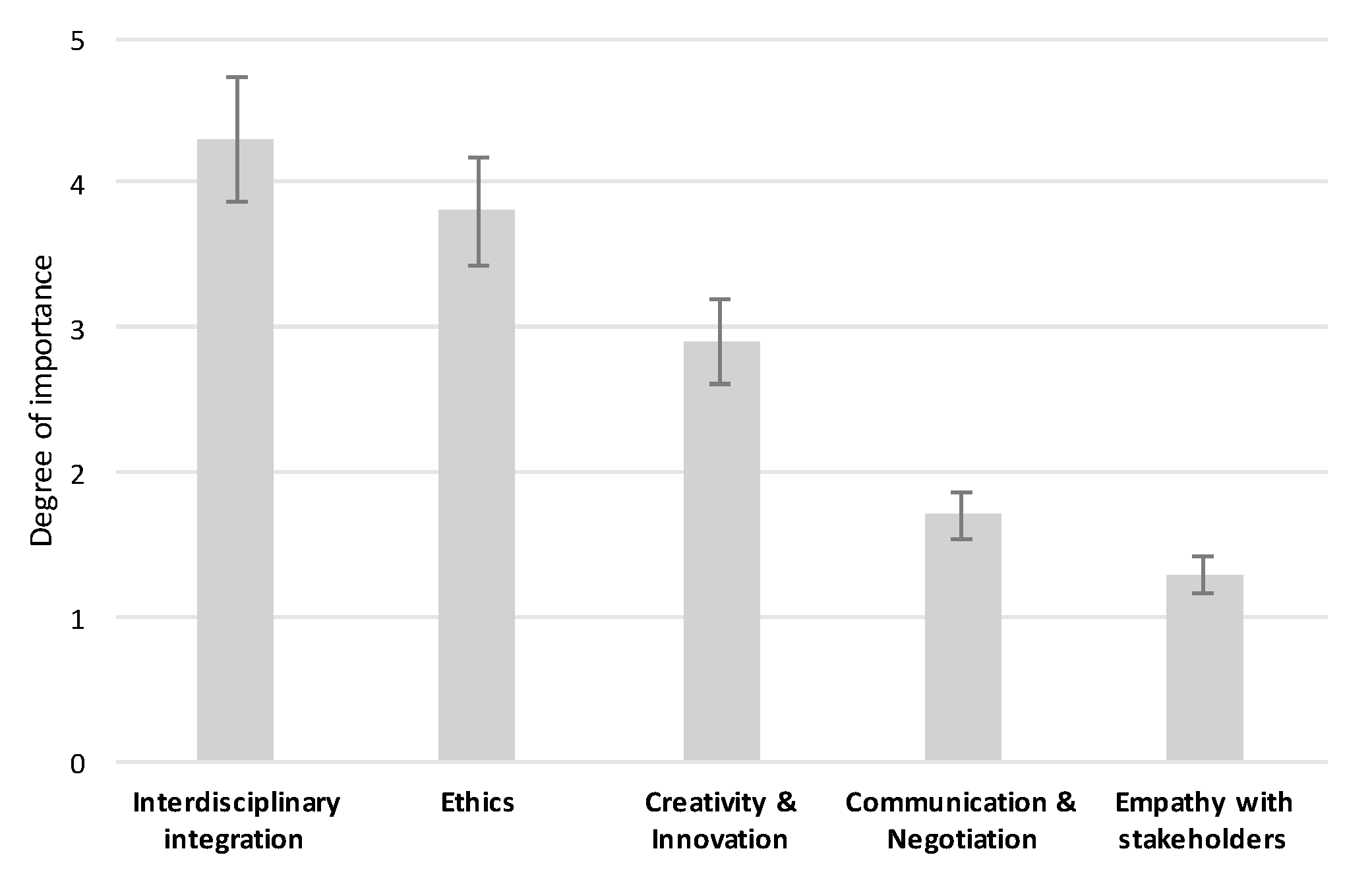
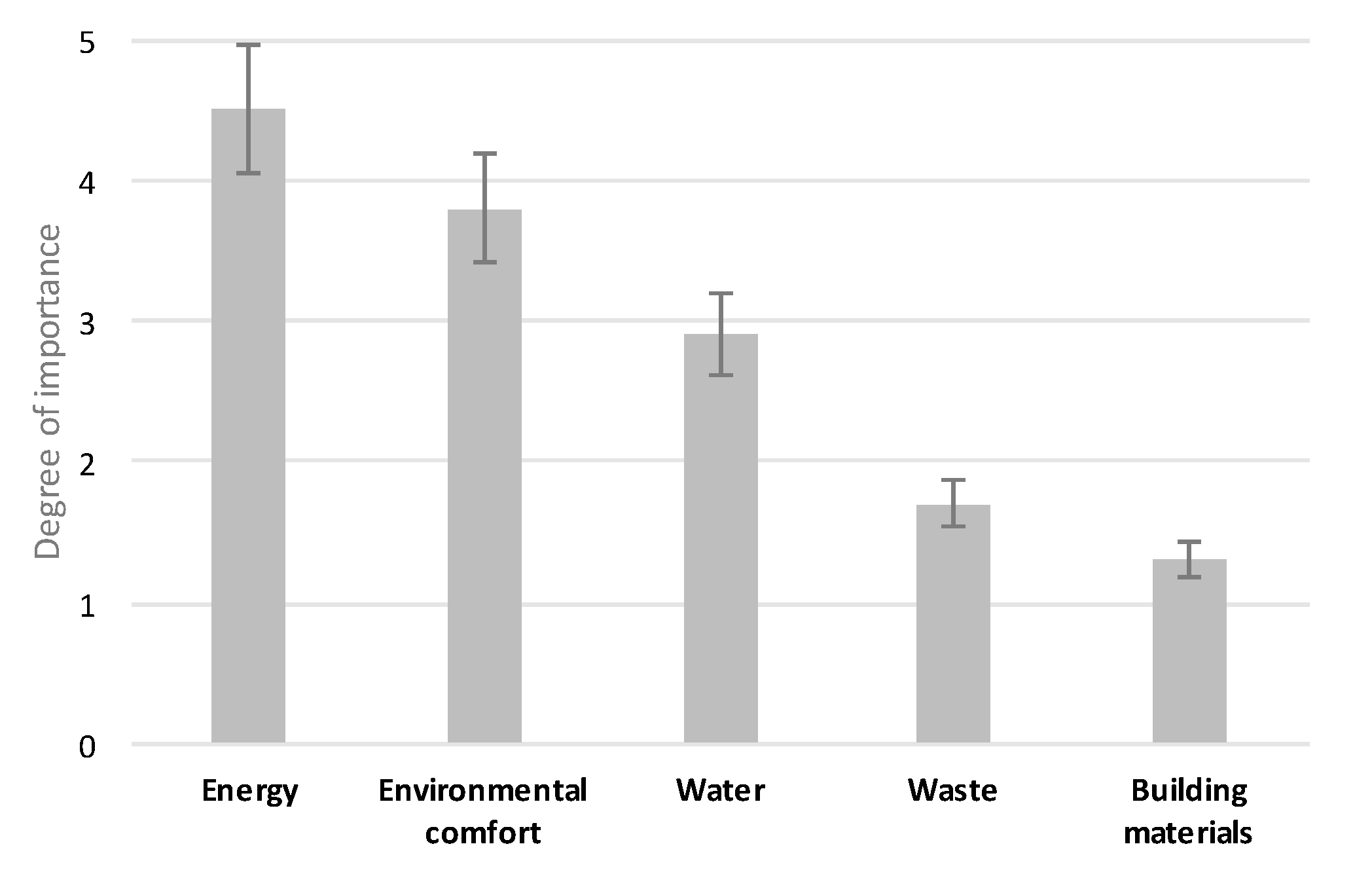
| Professional Function | Professional Profile |
|---|---|
| Surveyed | Professional title of: Architect or Civil Constructor or Civil Engineer or another related specialties. At least years as an evaluator or consultant of Energy efficiency by the Housing and Urbanism Ministry, Chile [42] Evaluator or Advisor in Sustainable Building Certification [42] |
| Interviewed | Professional title: Civil Engineer or other related specialties. At least years as an evaluator or consultant of Energy efficiency by the Housing and Urbanism Ministry, Chile [31] and/or evaluator or Advisor in Sustainable Building Certification [42]. Experience in university teaching in the area of SC. |
| Feasibility Assessment |
|
| Design |
|
| Planning Construction |
|
| Execution Construction Process |
|
| Technical Inspection |
|
| Reuse and Renovation |
|
| Demolition |
|
| Function | Description |
|---|---|
| I | Design projects that contain concepts of energy efficiency and SC. |
| II | Evaluation of SC projects. |
| III | Execute SC works. |
| IV | Technical work inspection (SC) |
| V | Certify SC. |
| VI | Integrate the technical disciplines of SC at any stage of the project’s life cycle. |
| VII | Manage SC businesses. |
| VIII | Advice on energy efficiency for buildings with emphasis on real estate value. |
| IX | Support the formulation and improvement of regulations. |
| X | Exercise research and innovation (R & D & i). |
| XI | Sustainably extend the life cycle of the works. |
| XII | Execute the demolition of the existing infrastructure in a sustainable way. |
| Global Competences | Description |
|---|---|
| Sustainable Evaluation | Evaluate the construction projects using sustainable criteria of viability in the implementation and operation of the building. |
| Sustainable Construction Certification | Judge the construction projects based on the application on the technical knowledge, SC systems and procedures in compliance with Chilean norms, regulations and laws. |
| Sustainable Facility Management | Manage the last stage of the life cycle of a construction Project to achieve the triple bottom line and the 7 sustainable principles. |
| Feasibility Assessment |
| Evaluate the construction projects’ feasibility using economy criteria, environmental norms, laws, regulations and the project’s acceptance by the community |
| Design |
| Design construction projects applying energy efficiency concepts in conjunction with the regulations and the technical specifications, demonstrating knowledge of materials, techniques and technologies of sustainable design, ensuring the optimum development of the task, for the benefit of the environment and social surroundings. |
| Planning Construction |
| Plan resources and labor, prioritizing the optimal use of materials, demonstrating economic benefits that can be obtained through continuous improvements in the execution of projects, thus generating greater sustainable viability projects. |
| Execution Construction Process |
| Execute SC labor, applying internationally standardized quality procedures, adequate SC techniques and procedures in all phases of labor, demonstrating knowledge and achieving the schedule; in order to help the environment, society and economy of the labor itself. |
| Technical Inspection |
| Preform sustainable technical labor inspection through the knowledge of current norms and applying measurements and verification instruments, visiting the sites and preparing reports about the status, in order to ensure good labor quality. |
| Reuse and Renovation |
| Plan the reuse of resources involved in the Project to meet the seven principles, balancing the social, economic and environmental aspects. |
| Demolition |
| Establish the closure of the construction project based on sustainable decision criteria to contribute to the society sustainable development. |
© 2018 by the authors. Licensee MDPI, Basel, Switzerland. This article is an open access article distributed under the terms and conditions of the Creative Commons Attribution (CC BY) license (http://creativecommons.org/licenses/by/4.0/).
Share and Cite
Valdés, H.; Correa, C.; Mellado, F. Proposed Model of Sustainable Construction Skills for Engineers in Chile. Sustainability 2018, 10, 3093. https://doi.org/10.3390/su10093093
Valdés H, Correa C, Mellado F. Proposed Model of Sustainable Construction Skills for Engineers in Chile. Sustainability. 2018; 10(9):3093. https://doi.org/10.3390/su10093093
Chicago/Turabian StyleValdés, Hugo, Christian Correa, and Felipe Mellado. 2018. "Proposed Model of Sustainable Construction Skills for Engineers in Chile" Sustainability 10, no. 9: 3093. https://doi.org/10.3390/su10093093
APA StyleValdés, H., Correa, C., & Mellado, F. (2018). Proposed Model of Sustainable Construction Skills for Engineers in Chile. Sustainability, 10(9), 3093. https://doi.org/10.3390/su10093093







